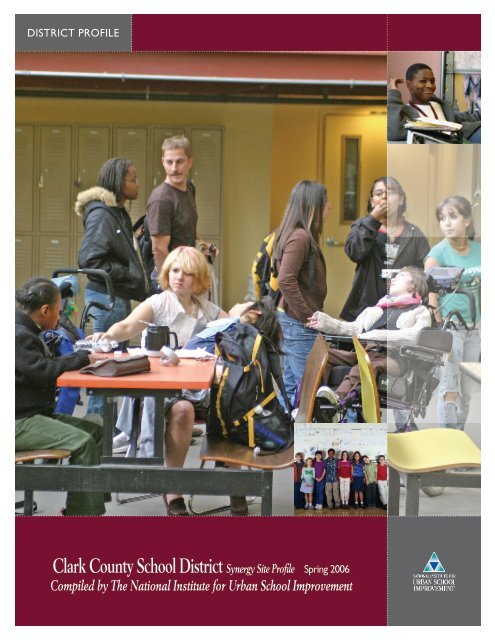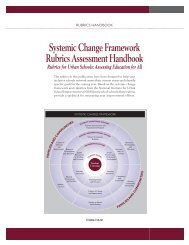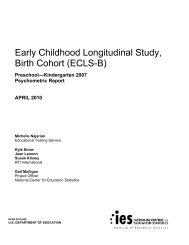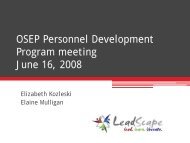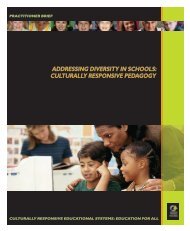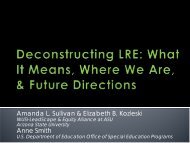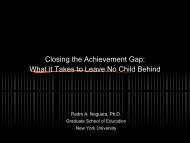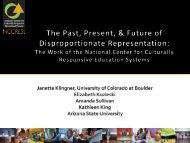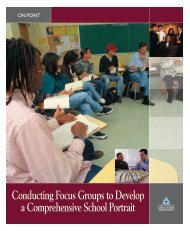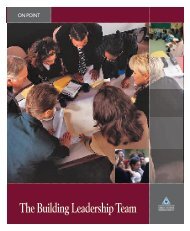Clark County School District Synergy Site Profile ... - NIUSI Leadscape
Clark County School District Synergy Site Profile ... - NIUSI Leadscape
Clark County School District Synergy Site Profile ... - NIUSI Leadscape
- No tags were found...
You also want an ePaper? Increase the reach of your titles
YUMPU automatically turns print PDFs into web optimized ePapers that Google loves.
DISTRICT PROFILE<strong>Clark</strong> <strong>County</strong> <strong>School</strong> <strong>District</strong> <strong>Synergy</strong> <strong>Site</strong> <strong>Profile</strong> Spring 2006Compiled by The National Institute for Urban <strong>School</strong> Improvement
n a t i o n a l i n s t i t u t e f o r u r b a n s c h o o l i m p r o v e m e n tfastest growing districts in the nation. They are currently rankedas the fifth largest school district in the United States, andenrollment has grown since each school year:Student Enrollment, 2003 - 2006<strong>School</strong> Year2003-2004 268,3572004-2005 280,8342005-2006 291,486Total Number of Students<strong>Clark</strong> <strong>County</strong> serves a diverse population of students: 0.8% AmericanIndian/Alaskan Native, 8.5% Asian/Pacific Islander, 37% Hispanic,14.3% Black/African American, and 39.3% White/Caucasian.Student Distribution, 2005with disabilities (10.8%), 59,092 students with limited Englishproficiency (21%), and 124,678 students qualifying for free orreduced lunch (44.4%).According to <strong>Clark</strong> <strong>County</strong> <strong>District</strong> Testing Information, forthe 2004-2005 school year, the percentage of special educationstudents that performed in the meeting standards range inmath was 16.2% for third grade, 14.3% for fifth grade, and8.6% for eighth grade. In addition, the percentage of specialeducation students that performed in the meeting standardsrange for reading was 14.2% for third grade, 12.2% for fifthgrade, and 9.4% for eighth grade. Both math and reading scoresindicate a decrease in number of special education studentsmeeting standards between third and eighth grade. Thepercentage of special education students in the meetingstandards range for science has remained relatively stablebetween fifth (16.4%) and eighth grade (16%).SPED Students criterion referenced testperformance, 2004 - 20053 rd Grade Math 16.20%Ethnic Group Number PercentageWhite 114,570 39.3%Reading 14.20%Hispanic 107,987 37.0%5 th Grade Math 14.30%African American 41,783 14.3%Reading 12.20%Asian 24,742 8.5%Science 16.40%Native American 2,428 0.8%8 th Grade Math 8.60%Exceptional Students In addition, during the 2003-2004school year, <strong>Clark</strong> <strong>County</strong> <strong>School</strong> <strong>District</strong> had 30,408 students<strong>Clark</strong> <strong>County</strong> <strong>School</strong> <strong>District</strong>, 2004-2005Reading 9.40%Science 16%Students with Disabilities 30,408 or 10.8%Limited English Proficiency 59,092 or 21%Free/Reduced Lunch 124,678 or 44.4%In 2005, the number of students with disabilities that spent 80%or more of their time in the general education classroom was 51%.This has steadily increased by seven percent from 44% in 2003.In addition, 31% of students with disabilities spent between 40and 79% of their time in the general education classroom in 2005.This number has decreased from 37% in 2003 and 32% in 2004.w w w. u r b a n s c h o o l s . o rgGreat Urban <strong>School</strong>s : Learning Together Builds Strong Communities5
n a t i o n a l i n s t i t u t e f o r u r b a n s c h o o l i m p r o v e m e n tWhile 17% of students with disabilities spent less than 39% of theirtime in general education classrooms in 2005, a decrease of 3%from the previous year, it is still well above the national average.least restrictive environmentdistrict wide, 2003 - 2005Percentage of Students with Disabilities60%50%40%30%20%10%Least Restrictive Environment<strong>District</strong> WideAmerican, and 5,710 were White. The dropout rate was7.2%. Of the 5,281 students that dropped-out, 74 were AmericanIndian/Alaskan Native, 342 were Asian/Pacific Islander, 1,954 wereHispanic, 799 were Black/African American, and 2,112 were White.The Staff A core belief of the <strong>Clark</strong> <strong>County</strong> <strong>School</strong> <strong>District</strong>is that all actions of a school district should lead to improvedstudent achievement. The district employs 34,249 full-time,part-time, substitute, and temporary staff members. Of those,16,817 are licensed personnel, 10,012 are support staff, 1209are administrators, and 144 are school police. In 2004-2005 thepercentage of classes not taught by highly qualified teacherswas 34.9% for Elementary, 44.8% for English, 47.2% for Math,and 51.4% for Science.Staff Members, 2005 - 20060%80 - 100% 40 - 79% Less than 39%2003 44% 37% 19%2004 48% 32% 20%2005 51% 31% 17%Percentage of Time in General EducationLicensed Personnel 16,817Support Staff (clerical, food service, busdrivers, aides, and custodians)10,012Graduation and Dropout Rate The preliminarynumbers for the graduation rate of <strong>Clark</strong> <strong>County</strong> <strong>School</strong> <strong>District</strong>as a whole for the 2004-2005 school year is estimated to be64.4%. This is up slightly from the previous year (2003-2004) inwhich the graduation rate was 62.7%. For the 2003-2004 schoolyear the information on graduation rates and dropout rates byethnicity was available. Of the 9,858 students that graduated, 62were American Indian/Alaskan Native, 999 were Asian/PacificaIslander, 2,022 were Hispanic, 1,065 were Black/AfricanGraduation and Dropout Rate, 2004EthnicityGraduationRateDropoutRateAmerican Indian/Alaskan Native 51.70% 11.90%Asian/Pacific Islander 71.80% 5.40%Hispanic 50.40% 9.60%Black/African American 50.00% 7.70%White 70.80% 6.00%Total Students 62.70% 7.20%Administrators 1,209<strong>School</strong> Police 144Substitute Teachers 3,243Other Temporary/Substitute Employees 2,824The <strong>School</strong>s The <strong>Clark</strong> <strong>County</strong> Public <strong>School</strong> <strong>District</strong>operates 317 schools as of the 2005-2006 school year: 193Elementary schools (70 of which are year-round), 53 Middleschools, 40 High schools, 31 Alternative schools and Specialschools. <strong>Clark</strong> <strong>County</strong> opened 11 new schools in the fall of2005 (seven elementary schools, three middle schools, and onehigh school). One special school was opened in January 2006and ten schools are scheduled to open in August 2006.Programs are available to meet the broad spectrum of students’education needs. These include:• Magnet schools and programs The district offers 17magnet schools and programs, (five elementary, four middleand eight high school programs), to which students may applybased on their interests and abilities. Areas of emphasisinclude math and science, fine and performing arts,w w w. u r b a n s c h o o l s . o rgGreat Urban <strong>School</strong>s : Learning Together Builds Strong Communities6
n a t i o n a l i n s t i t u t e f o r u r b a n s c h o o l i m p r o v e m e n ttechnology, tourism and travel, aerospace and aviation,medical, and law and leadership professions.enrollment in magnet programs, 2004 - 2005ProgramCareers andProfessionsCommunication/HumanitiesInternationalEducationMath/Science &TechnologyNumber of<strong>School</strong>sEnrollment15 7,042 Sr. High8 3,35212 8,65713 6,875Type of <strong>School</strong>3 Elementary, 2Middle, 3 Sr. High5 Elementary, 4Middle, 3 Sr. High4 Elementary, 7Middle, 2 Sr. HighMontessori 4 1,163 ElementaryVisual &Performing Arts16 5,562Total 68 32,6515 Elementary, 6Middle, 5 Sr. High• Special education Direct and support services areprovided for students with disabilities ages 3 to 21. <strong>School</strong>teams collaborate with families to offer quality learningexperiences and prepare students with disabilities for life afterschool. Neighborhood schools are the focus for providingservices, and a full range of options is available to meetstudents’ needs.• Accelerated/honors programs A Gifted and TalentedEducation Program is offered in grades three through five.Every high school offers an Honors Program that provides anacademically challenging curriculum. Students may also selectfrom Advanced Placement courses or choose to earn anadvanced diploma.• Other programs/outside resources The district offerstransitional bilingual and English as a second languageprograms, as well as numerous alternative education optionsfor high school students. The district also uses outsideresources to meet students’ needs through supplementalprogram such as Safe and Drug Free <strong>School</strong>s.The CCSD is focusing on three areas to improve studentperformance: achievement, access and accountability. Themission of the district is to provide students the knowledge,skills, attitudes and ethics necessary to succeed academicallyand to practice responsible citizenship. These areas arediscussed in more detail in sections below.In recent years many school districts have implemented formsof school-based, shared decision making in their efforts toimprove results for all students. Shifting of accountability toschools has had a profound impact on the work of centraldistrict administrators. With schools as the critical clients ofdistrict work, central administrators have had to reevaluatetheir organizational and collaborative work structures to ensurethat they provide the support that schools needs to improveresults for all students. This shift in relationship betweenschools and central administration has been difficult tonegotiate both at the organizational and at the individual level,since it requires a reconceptualization of the formal andinformal power structures within the district.One way of thinking about the functions of centraladministration is provided by the systemic change frameworkwhich organizes the work of schools into seven key areas: (1)systemic infrastructure, (2) culture of renewal and improvement,(3) inquiry on schools and schooling, (4) organizational support,(5) resource development and allocation, (6) student services,and (7) district and community partnerships.Systemic InfrastructureThe bureaucratic structure supports the work of schools, facilitatingcommunication, networking, resource acquisition, entrepreneurship,and innovation (i.e. matrixed organizations, data systems, feedbackloops, communication across and within levels).In <strong>Clark</strong> <strong>County</strong>, the Board of Trustees are elected and serveoverlapping 4-year-terms. Each member serves a differentregion and coordinates efforts with other board members<strong>School</strong> Board members, 2005 - 2006Sheila R. MoultonShirley BarberRuth L. JohnsonLarry P. MasonSusan Brager-WellmanMary Beth ScowTerri JanisonSuperintendent of <strong>School</strong>sWalt Rulffesw w w. u r b a n s c h o o l s . o rgGreat Urban <strong>School</strong>s : Learning Together Builds Strong Communities7
n a t i o n a l i n s t i t u t e f o r u r b a n s c h o o l i m p r o v e m e n tthrough the direction of the superintendent. Additionally, eachtrustee hosts monthly parent advisory committee meetings topromote communication with parents and community membersand to provide information about important issues in education.The <strong>Clark</strong> <strong>County</strong> <strong>School</strong> <strong>District</strong> is organized into fivegeographic regions – Northwest, Northeast, East, Southeastand Southwest – to improve achievement, access andaccountability. Under the leadership of its regionsuperintendent, each region is responsible for developingprograms and services tailored to the needs of its community.Each region also offers a Region center to bring districtresources, staff and information closer to parents and students.Inquiry on <strong>School</strong>sand <strong>School</strong>ingEducators, families, and students are engaged in ongoing reflection andpracticed-based inquiry in classrooms and schools (i.e. classroom practicesthat support learners with diverse abilities, backgrounds and, languages,data policies and, procedures, school improvement).Equity and Diversity Education promotes the development ofculturally responsible and responsive educational policies, practices,and curricula that fosters knowledge, understanding, respect, andappreciation of all students. The goals of this program are:1. To influence policies and practices that support qualityteaching, learning, and leadership2. To assist educators in creating culturally supportive learningenvironments that hold high expectations for the academicachievement of students3. To review and support the development and/or evaluationof culturally responsible and responsive curricula4. To consult with school district personnel involved ineducational settings outside the classroom regarding theappropriateness of culturally diverse programs and resources5. To assist the district and schools in resolving diverseeducational issues affecting educators, students, parents, andthe community6. To provide technical assistance in the review and integrationof culturally diverse materials and resources to support thecurriculum within the school and classroom programs7. To facilitate and serve as a liaison in the development andpresentations of conferences, workshops, institutes, andother educational programs in collaboration withinstitutions of higher learning and professional organizationsdesigned to enhance cultural appreciation and diversityprogramming for educators, students, and the community8. To represent the <strong>Clark</strong> <strong>County</strong> <strong>School</strong> <strong>District</strong> byadvocating for diversity and equity issues for students,parents, community, and other educational programs9. To establish partnerships with community-basedorganizations that support educational programs connectedto students, parents, and other community groupsOrganizational SupportThoughtful supports provide coherent, continuous opportunitiesfor improved practices (i.e. professional development, reportingto parents and community, mentoring).<strong>Clark</strong> <strong>County</strong> <strong>School</strong> <strong>District</strong> has a division devoted toCurriculum and Professional Development. The mission ofthe Curriculum and Professional Development Division is tosupport increased student achievement, as outlined in the A+in Action Accountability Plan, by• providing relevant curriculum materials and training forteachers, support staff, and administrators• offering academic services for parents and communitymembers• coordinating and promoting leadership and extracurricularactivities for studentsThe following is a list of current professional development trainingsthat address special education and Inclusive <strong>School</strong> Practices:• Step by Step for Inclusive <strong>School</strong>s: Day One• Step by Step for Inclusive <strong>School</strong>s: AnOverview for Administrators• Leadership Skills for EffectiveChange - Sustaining Change• Leadership Skills for Effective Change• Technical Assistance for Inclusive EducationResource Developmentand Allocation<strong>District</strong>s strategically and flexibly develop and allocate resources to supportthe work of schools (i.e. special projects and initiatives, equity amongschools, externally funded projects [private, demonstration, corporate]).w w w. u r b a n s c h o o l s . o rgGreat Urban <strong>School</strong>s : Learning Together Builds Strong Communities8
n a t i o n a l i n s t i t u t e f o r u r b a n s c h o o l i m p r o v e m e n tSeven CCSD schools are partnering with Edison <strong>School</strong>s, thenation’s largest private manager of public schools. They are:Cahlan ES, Crestwood ES, Lincoln ES, Lynch ES, Park ES,Ronnow ES and West MS. Founded in 1992, Edison <strong>School</strong>s isthe nation’s leading partner with public schools and schooldistricts, focused on raising student achievement through itsresearch-based school design, uniquely aligned assessmentsystems, interactive professional development, integrated use oftechnology and other proven program features.In 2003-2004, per pupil expenditures were approximately $5,754,and are broken down respectively: instruction 61%, instructionsupport 13.8%, operations 17.1%, and leadership 8.1%.DISTRICT — PER PUBIL EXPENDITURES, 2003 - 2004Citizens and businesses also have many opportunities to becomeinvolved in CCSD schools:• The <strong>School</strong>-Community Partnership Programfacilitates curriculum-enhancing programs and activitiesfor students in all grades with the help of local businessesand public and private groups.• The <strong>Clark</strong> <strong>County</strong> Public Education Foundationis an independent non-profit corporation dedicated toraising funds for projects and initiatives designed toimprove public schools.• The Career and Technical Education Departmenthelps students achieve their career goals with the assistanceof local employers by providing job shadowing, mock jobinterviews, paid work experience, internships, communityservice and school-based enterprise.In addition to the above community links, CCSD strives tocreate a link to facilitate parent contact and involvement.CCSD cites research that shows that students with parents whoare involved in their children’s education achieve more. Theyrealize that some parents have the time available to volunteer ina classroom or serve on committees, whereas others have morelimited opportunities. Keeping this in mind, they have created anumber of opportunities for parents to be involved in schools:Attendance Zone Advisory Commission (AZAC)AZAC reviews attendance zones every year and providesrecommendations to trustees concerning necessary changes toattendance boundaries. The 15-member committee consists ofindividuals from the community, appointed by the Board of<strong>School</strong> Trustees. All meetings are open to the public.<strong>District</strong> and CommunityPartnershipsHealthy, productive partnerships exist among community,government, colleges and universities, and schools to further therenewal and improvement of schools (i.e. existing partnership,teacher preparation and induction).<strong>Clark</strong> <strong>County</strong> resolves to encourage parents, families, and thesurrounding community to be involved in their child’s educationat all grade levels. Parents may assist in classrooms or participatein parent organizations, booster clubs, parent advisorycommittees and region committees.Bond Oversight Committee (BOC) An independent 19-member body that monitors compliance with building programgoals, advises the Board of <strong>School</strong> Trustees on capital bond fundconstruction programs, and keeps the public informed. BOCmembers are appointed by the Board of <strong>School</strong> Trustees. Thepublic is invited to attend these meetings.Friends of Special Education A support group forparents with children requiring special services. Parents whohave concerns about their child’s education, IEP, or services arematched with a parent volunteer from the Friends networkwhose child has the same type of disability, and who canprovide direction and suggestions.Sex Education Committee An advisory committee,consisting of parents and community members, who advise theboard concerning the content and materials to be used inw w w. u r b a n s c h o o l s . o rgGreat Urban <strong>School</strong>s : Learning Together Builds Strong Communities9
n a t i o n a l i n s t i t u t e f o r u r b a n s c h o o l i m p r o v e m e n tclassroom instruction, and the recommended grade levelsat which the instruction is offered.Ad Hoc Committees From time to time, the board createscommittees with the task of studying specific concerns, such asreading or the dropout rate. Parents are often appointed bytrustees to serve on these committees.Newsletter Mailing List Some board members sendnewsletters on a regular basis.Parent Advisory Committees (PAC) Each trusteeorganizes a PAC designed specifically to encouragecommunication between parents and board members.Regular Board Meetings <strong>School</strong> board meetings areheld regularly. Although the public is encouraged to attendboard meetings, they are also encouraged to attend thecommittee meetings listed above to have greater input onmatters of concern to them.Culture of Renewaland ImprovementThere’s a culture that supports growth and development - personally,professionally, and organizationally. Risk taking and failure are seen asopportunities for growth (i.e. district vision, risk-taking climate, districtstandards, investment in collective & individual, professionaldevelopment).The district operates one of the nation’s largest schoolconstruction and modernization programs. Approximately$3.7 billion is being spent through 2008 to build newschools and improve existing schools. The district opened 13new schools in August 2004 (seven elementary schools, threemiddle schools and three high schools), and 11 new schoolsin the fall of 2005 (seven elementary schools, three middleschools, and one high school). One special school was openedin January 2006 and ten schools are scheduled to open inAugust 2006.<strong>NIUSI</strong> <strong>District</strong>Partnership, 2004-2005<strong>School</strong> Year<strong>Clark</strong> <strong>County</strong> has 63 schools that have partnered with theNational Institute’s efforts. The National Institute held aleadership retreat with senior level district administrators andhas engaged school and district level leadership in ongoingleadership academies on differentiated instruction. The districtworked with <strong>NIUSI</strong> to host a site liaison professionaldevelopment meeting, which included a site visit to CramMiddle <strong>School</strong>. A parent advisory group has been established inthe district to work on Institute strategies, and a synergyadvisory board has been established. A direct link to the <strong>NIUSI</strong>web site has been placed on the student services exchange onthe district web site. This link will provide folders forprofessional reading, teacher dialogue, announcements and otherpertinent web links on district web site. All 300 schools in<strong>Clark</strong> <strong>County</strong> will participate in NISW. Additionally the districtis working with the Institute to ensure that surveys/observationsare being conducted to measure implementation of initiatives todate. <strong>NIUSI</strong> provided financial support for participation of 5National Board Certified Teachers as Coaches to assist with datacollection and provide technical assistance to school sites.Creating the <strong>Profile</strong>A variety of sources informed this profile. Some of the informationabout the district itself came from the district’s website, whichprovides a broad spectrum of information. Additionally, websitesof the Nevada State Department of Education and EducationCommission of the States were consulted for current information.National Institute staff, Barbara Sparks, Mackenzie Meredith, andSwati Jain developed and updated information as necessary.Elizabeth Kozleski created the original structure of the profileand wrote the introduction for the document.Additionally, the Professional Development Division ofCurriculum and Professional Development is dedicatedto continually improving the quality of schools.The Professional Development Division operates to trainCCSD staff through the utilization of professionaldevelopment workshops and classes.w w w. u r b a n s c h o o l s . o rgGreat Urban <strong>School</strong>s : Learning Together Builds Strong Communities10
gREAT URBAN SCHOOLS:vProduce high achieving students.vConstruct education forsocial justice, access and equity.vExpand students’ life opportunities,available choices and community contributions.vBuild on the extraordinary resources thaturban communities provide for life-long learning.vUse the valuable knowledge and experience thatchildren and their families bring to school learning.vNeed individuals, family organizations and communities towork together to create future generations of possibility.vPractice scholarship by creating partnershipsfor action-based research and inquiry.vShape their practice based on evidence of whatresults in successful learning of each student.vFoster relationships based on care,respect and responsibility.vUnderstand that people learn in differentways throughout their lives.vRespond with learningopportunities that work.Great Urban <strong>School</strong>s: Learning Together Builds Strong Communities


